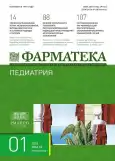Динамика лабораторных показателей крови у детей с атопическим дерматитом, получавших биологическую терапию ингибитором ИЛ-4, ИЛ-13 в сочетании с методами наружной терапии
- Авторы: Русакова Л.Л.1,2, Мурашкин Н.Н.1,3,4
-
Учреждения:
- Национальный медицинский исследовательский центр здоровья детей
- Брянский областной кожно-венерологический диспансер
- Первый Московский государственный медицинский университет имени И.М. Сеченова (Сеченовский Университет)
- Центральная государственная медицинская академия Управления делами Президента РФ
- Выпуск: Том 32, № S1 (2025)
- Страницы: 40-49
- Раздел: Оригинальные статьи
- Статья опубликована: 08.11.2025
- URL: https://journals.eco-vector.com/2073-4034/article/view/687877
- DOI: https://doi.org/10.18565/pharmateca.2025.1-s1.40-49
- ID: 687877
Цитировать
Полный текст
Аннотация
Цель исследования: оценить динамику лабораторных показателей крови и безопасность использования ингибитора ИЛ-4, ИЛ-13 (дупилумаб) в сочетании с методами наружной терапии в детском возрасте старше двух лет при среднетяжелом и тяжелом атопическом дерматите в аспекте двухлетнего наблюдения.
Материалы и методы: Проведено двухлетнее наблюдательное исследование 120 детей в возрасте от двух до 17 лет с атопическим дерматитом, получавших биологическую терапию дупилумабом в сочетании с методами наружной терапии. Пациенты были распределены на три группы по характеру проводимой терапии. На 16-й, 28-й, 52-й, 64-й, 104-й неделе наблюдения всем пациентам проводились лабораторные клинические анализы крови и мочи, биохимический анализ крови, исследование уровня общего IgE.
Результаты: Влияние ингибитора ИЛ-4, ИЛ-13 (дупилумаб) в сочетании с разными методами наружной терапии у детей при АтД в течение двухлетнего наблюдения показало, что динамика биохимических показателей крови не претерпела статистически значимых изменений (p>0,05). Во всех группах на протяжении всего периода наблюдения эти показатели находились в пределах референсных значений. Лабораторные показатели ОАК продемонстрировали незначительную эозинофилию, которая при продолжении лечения снизилась до нормальных значений. Со стороны ОАМ также не выявлено статистически значимых изменений. А при оценке уровня IgE наблюдалось устойчивое от периода к периоду статистически значимое (p<0,05) снижение лабораторных показателей.
Заключение: Долгосрочная оценка динамики лабораторных показателей у детей старше двух лет со среднетяжелым и тяжелым АтД в аспекте двухлетнего наблюдения, получавших Дупилумаб в сочетании с комплексными методами наружной терапии, продемонстрировали отсутствие необходимости лабораторного мониторинга и подтвердили безопасность и эффективность данной терапии и профилактики обострений АтД, что указывает на целесообразность дополнения комплексного алгоритма лечения.
Полный текст
Об авторах
Людмила Леонидовна Русакова
Национальный медицинский исследовательский центр здоровья детей; Брянский областной кожно-венерологический диспансер
Email: m_nn2001@mail.ru
ORCID iD: 0000-0003-4297-4631
младший науч. сотрудник лаборатории патологии кожи у детей, заместитель главного врача по медицинской части, главный внештатный специалист по дерматовенерологии и косметологии ДЗ Брянской области
Россия, Москва; БрянскНиколай Николаевич Мурашкин
Национальный медицинский исследовательский центр здоровья детей; Первый Московский государственный медицинский университет имени И.М. Сеченова (Сеченовский Университет); Центральная государственная медицинская академия Управления делами Президента РФ
Автор, ответственный за переписку.
Email: m_nn2001@mail.ru
ORCID iD: 0000-0003-2252-8570
доктор медицинских наук, профессор, руководитель НИИ детской дерматологии, зав. отделением дерматологии и аллергологии, зав. лабораторией патологии кожи у детей отдела научных исследований в педиатрии, профессор кафедры дерматовенерологии и косметологии, профессор кафедры педиатрии и детской ревматологии
Россия, Москва; Москва; МоскваСписок литературы
- Коннов П.Е., Арсеньева А.А. Эффективность и безопасность применения первого таргетного биологического препарата Дупилумаб в терапии тяжелого непрерывно-рецидивирующего атопического дерматита. Вестник дерматологии и венерологии. 2023;99(1):62–70. [Konnov P.E., Arsenieva A.A. Efficacy and safety of the first targeted biological drug dupilumab in the treatment of severe continuously relapsing atopic dermatitis. Vestnik Dermatologii i Venerologii. 2023;99(1):62–70. (In Russ.)]. doi: https://doi.org/10.25208/ vdv1384
- Зайнуллина О.Н., Хисматуллина З.Р., Печкуров Д.В. Проактивная терапия атопического дерматита у детей с применением эмолентов. Клиническая дерматология и венерология. 2020;19(1):87–91. [Zajnullina O.N., Xismatulina Z.R., Pechkurov D.V. Proactive therapy of atopic dermatitis in children using emollients. Klinicheskaya dermatologiya i venerologiya. 2020;19(1):87–91. (In Russ.)]. doi: https://doi.org/10.17116/klinderma20201901187
- Paller A.S., Siegfried, E.C., Cork, M.J. et al. Laboratory Safety from a Randomized 16-Week Phase III Study of Dupilumab in Children Aged 6 Months to 5 Years with Moderate-to-Severe Atopic Dermatitis. Pediatr Drugs. 2023;25:67–77. doi: https://doi.org/10.1007/s40272-022-00553-8
- Weidinger S., Beck L.A., Bieber T., et al. Atopic dermatitis. Nat Rev Dis Primers. 2018;4(1):1. doi: https://doi.org/10.1038/s41572-018-0001-z.
- Boguniewicz M., Alexis A.F., Beck L.A., et al. Expert Perspectives on Management of Moderate-to-Severe Atopic Dermatitis: A Multidisciplinary Consensus Addressing Current and Emerging Therapies. J Allergy Clin Immunol Pract. 2017 Nov-Dec;5(6):1519–1531. doi: https://doi.org/10.1016/j.jaip.2017.08.005
- Wollenberg A., Beck L.A., Blauvelt A., et al. Laboratory safety of dupilumab in moderate-to-severe atopic dermatitis: results from three phase III trials (LIBERTY AD SOLO 1, LIBERTY AD SOLO 2, LIBERTY AD CHRONOS). Br J Dermatol. 2020 May;182(5):1120-1135. doi: https://doi.org/10.1111/bjd.18434
- Arkwright P.D., Motala C., Subramanian H., et al.; Atopic Dermatitis Working Group of the Allergic Skin Diseases Committee of the AAAAI. Management of difficult-to-treat atopic dermatitis. J Allergy Clin Immunol Pract. 2013 Mar;1(2):142–51. doi: https://doi.org/10.1016/j.jaip.2012.09.002
- Drucker A.M., Eyerick K., de Bruin-Weller M., et al. Use of systemic corticosteroids for atopic dermatitis: International Eczema Council consensus statement. Br J Dermatol. 2018;178(3):768–75.
- Paller A.S., Wollenberg A., Siegfried E., et al. Laboratory Safety of Dupilumab in Patients Aged 6-11 Years with Severe Atopic Dermatitis: Results from a Phase III Clinical Trial. Paediatr Drugs. 2021 Sep;23(5):515–527. doi: https://doi.org/10.1007/s40272-021-00459-x
- Siegfried E.C., Bieber T., Simpson E.L., et al. Effect of Dupilumab on Laboratory Parameters in Adolescents with Atopic Dermatitis: Results from a Randomized, Placebo-Controlled, Phase 3 Clinical Trial. Am J Clin Dermatol. 2021 Mar;22(2):243–255. doi: https://doi.org/10.1007/s40257-020-00583-3
- Le Floc’h A., Allinne J., Nagashima K., et al. Dual blockade of IL-4 and IL-13 with dupilumab, an IL-4Rα antibody, is required to broadly inhibit type 2 inflammation. Allergy. 2020 May;75(5):1188–1204. doi: https://doi.org/10.1111/all.14151
Дополнительные файлы




























